BEACHES AND SWIMMING IN JAPAN
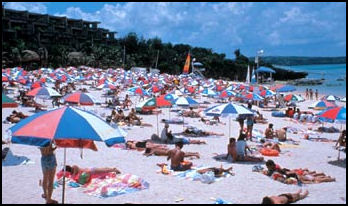
crowded beach in Okinawa Japan has many wonderful places to go swimming but the water is sometimes cold. Beaches on the Pacific Ocean may have rough seas, large waves and tricky currents that are potentially dangerous. The water is much calmer on the Japan Sea side of Japan. The best places to swim are in the calm waters in bays, coves and inlets. But these are often developed . The main swimming season is from June to October. The beaches on the eastern side of the country are sunnier and have less rain than those on the west side. It is also possible to swim in the rivers and lakes but they also tend to be cold. Most cities and resort areas have public pools in addition to the private pools at fancy hotels and resorts. Some resort hotels have heated pools which are open in the winter.
Boso Peninsula (east of Tokyo in Chiba Prefecture) is a region in the Kanto area known for its scenic seascapes and, beaches Tateyama (reached by train from Tokyo Station) makes a good base for exploring the Boso Peninsula. Nearby are empty Pacific beaches. Shirahama (southern part of the Boso Peninsula) has good surfing wave and some of the last “ama” (female divers) in Japan. Kamakura (45 minutes south of Tokyo by train) is a small historically-rich coastal town that attracts surfers with its beaches. Shimoda (near southern tip of the Izu Peninsula) boasts white sand surfing beaches and great seafood restaurants. There are beautiful beaches at Yumigahama.
Shirahama (2¼ hours by train from Osaka) is a developed hot-spring-beach resort on the west coast of Wakayama and the Kii Peninsula. The white sand beach, with sand brought in from Australia, draws huge crowds in the summer. The other main attraction is Sakino-yu hot springs, with bath built in some rocks on a point, offering great views of the sea. Tottori Sand Dunes (near Tottori) extend along the Sea of Japan for 16 kilometers north of Tottori and extend inland for about two kilometers. The dunes are whipped up by winds into conical piles, crescent-shaped hollows and various other patterns. The highest dune is a bout 300 feet high. The dunes turn a spectacular crimson red at sunset. Amonohashidate (near Tottori) contains a sandspit that is regarded as one of Japan's "Three Best Views." On the Pacific side of Shikoku and the Kii Peninsula east of Osaka there are some good surfing beaches.
On Kyushu there are some nice beaches near Miyazaki. Ibusuki (30 miles south of Kagoshima) is noted for its white sand beaches and natural hot sand baths which can be taken right on the beach. Altogether a 16-mile stretch of beach is heated by subterranean volcanic activity. There are lots of nice beaches with clear water on Okinawa and other islands south of the main Japanese islands. The northern part of the main island of Okinawa is relatively unspoiled. There are nice beaches at Sesoko-jima Island, Minna-jima Island and Okuma beach. The Miyako Islands (190 miles southwest of Okinawa) contains nice beaches and snorkeling and diving reefs.
Websites: Good list of Beaches About.com 100 Best Beaches in Japan Ikjeld.com ; 7 Good Beaches Traveljab blog
Boso Peninsula
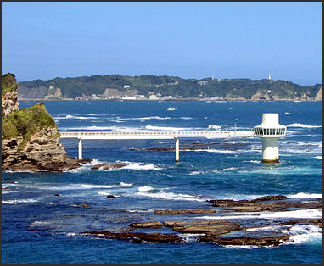
Boso Peninsula (east of Tokyo in Chiba Prefecture) is a region in the Kanto area known for its scenic seascapes, beaches fishing villages and warm climate. Some of the coastal roads are good for bicycling. To get there take JR express trains on the Uchibo Line or the Stobo Line. They both take about two hours to get there. Katsuura is the home of one of the three largest morning markets in Japan. Website: Chiba Tourism site chiba-tour.jp
Tateyama (reached by train from Tokyo Station) makes a good base for exploring the Boso Peninsula. Located near the southern tip of the peninsula, it is a pleasant town with 50,000 people and is popular among Tokyoites aiming to escape city life. Nearby are empty Pacific beaches, old Shinto shrines, fields full of carnations, rice paddies, Japan’s largest reclining Buddha, Tateyama Wild Bird sanctuary (with observation towers) and Nambo Paradise (Japan’s second largest botanical garden). Website: Chiba Tourism site chiba-tour.jp
Kamogawa Sea World (in Kamogawa, Chiba Prefecture) contains what is believed to be the largest sun fish it existence. It measures 193 centimeters across and weighs 350 kilograms. When it was caught off the Boso Peninsula in 1997 it measured 74 centimeters across and weighed 20 kilograms. It is fed a “luxury” meal of 3.4 kilograms of shrimp, oysters and tuna everyday. The sea park also has orca shows, trained seals, penguins and aquarium with a wide variety of fish. Website: Chiba Tourism site chiba-tour.jp
Wadamachi (Boso Peninsula in Chiba Prefecture) is the only town in the Kanto area where local people are still engaged in the whale industry. Restaurants and roadside shop specialize in whale dishes such as mink whale sushi and sashimi and sliced whale skin.
Myogane Cape (southern part of the Boso Peninsula) has some interesting tidal pools. When the tide is out you can see all kinds of sea creatures including sea anemones, sea cucumbers in the tidal pools. Surfers head to Shirahama Beach.
Shirahama (southern part of the Boso Peninsula) has good surfing waves and is home to shops that sell whale sauce and some of the last “ama” (female divers) in Japan. There are about 300 ama left. Many are in theirs 60s and 70s and have been diving professionally since they were teenagers. In 2002, one was still working at the age 89. They are most busy in the abalone gathering season which runs from May through July Website: Chiba Tourism site chiba-tour.jp
See Separate Article NEAR TOKYO: SAITAMA AND CHIBA factsanddetails.com
Izu Islands
THE IZU ISLANDS is a group of seven main volcanic islands — Oshima, Hachijojima, Miyakejma. Kozushima. Mikurajima and Toshima — about 163 kilometers (100 miles south of Tokyo). All of them are essentially the peaks of submerged volcanos. They have a relatively warm, dry climate the entire year and were used for penal colonies in the Edo period (1603-1868).

empty beach in Izu ilsands The islands are administratively part of Tokyo. Tokyo Metropolis contains over 100 islands, 11 of which are permanently inhabited. The Izu Islands, a group of nine, are abundant in nature, with wild coastal hot springs.
The largest islands — Oshima and Hachijojima — are regarded as “towns” while the smaller islands — Miyakejma. Kozushima. Mikurajima and Toshima — are considered “villages.”
One traveler wrote “Time slows down on these peaceful islands, with the hot springs, desert, and views of Mt. Fuji all showcasing that Tokyo has much more to offer than just the bright lights and bustle of the city. nI bloom here, and if you make your way to the top of the hill, you get a magnificent view of Mt. Fuji standing tall in the distance across the ocean.
Getting There: The islands can be reached by ferry or plane. Ferries depart for the Izu Islands from Tokyo Takeshiba Passenger Ship Terminal. Direct flights from Chofu Airport and Haneda Airport are also available. Lonely Planet Lonely Planet Websites: Tokyo Islands tokyo-islands.com ; Wikipedia Wikipedia ; Wikitravel Wikitravel
Mikurashima (30 kilometers south of Miyakejima) is known as the "island of the dolphins." About 270 Indo-Pacific bottlenose dolphins are known to inhabit the waters around Mikurajima. Dolphin-viewing trips are popular. Website: Tokyo Islands tokyo-islands.com ;
Hachijo-jima Island (290 kilometers south of Tokyo) is the second largest and southernmost of the Izu islands (68 square kilometers). The site of a penal colony from the 17th and 19th century, it boasts spectacular volcanic scenery, thick subtropical greenery and deep blue waters. Attractions include a dormant volcano, shrines and temples. Bicycles and cars can be rented. Bull-versus-bull fights are frequently held here. Scuba divers can observe underwater lava formation, spot turtles dolphins and see schools of tuna. The lack of beaches doesn’t keep surfers away. Website: Tokyo Islands tokyo-islands.com
See Separate Article SHIZUOKA, IZU PENINSULA AND IZU ISLANDS factsanddetails.com
Wakayama: Beaches and Tourist Areas
Wakayama Prefecture covers 4,725 square kilometers (1,824 square miles), is home to about 964,000 people and has a population density of 204 people per square kilometer. Wakayama is the capital and largest city, with about 364,000 people. It is in the Kansai area near Osaka and Kyoto on the central part of Honshu island and has six districts and 30 municipalities. Tourist Information Office JR Shingu Station, 2-1-1 Jofuku, Shingu City, Wakayama Pref., Tel. 0735-22-2840. Hours: 9:00am-6:30pm Website: Shingu Tourist Information Center; kumano-shingu.com
Shirahama (2¼ hours by train from Osaka) is a developed hot spring, beach resort on the west coast of Wakayama and the Kii Peninsula. The white sand beach, with sand brought in from Australia, draws huge crowds in the summer. The other main attraction is Sakino-yu hot springs, with baths built in some rocks on a point, offering great views of the sea. Websites:JNTO file Japan.travel ; Wikitravel Wikitravel Map: shirahama-ryokan.jp/en/access Hotel Web Sites: Ryokan and Minshuku Japanese Guest Houses Japanese Guest Houses Budget Accommodation: Japan Youth Hostels Japan Youth Hostels Check Lonely Planet books Getting There: Shirahama is accessible by train from Wakayama, Osaka , Kobe, Kyoto and Nara. Lonely Planet Lonely Planet
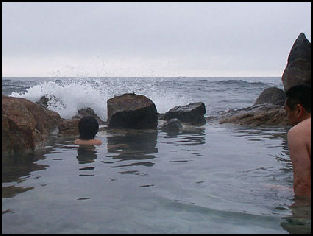
The Coastal Area of Yoshino-Kumano National Park is characterized more by cliffs and rocks than beaches. Having fewer flat ridges, the steep mountains in the mature stage are right at the water, creating a place where sea cliffs are well developed due to strong waves of the Kumano-nada Sea along the coast. Due to repeated patterns of sedimentation and prominence, the coastal line became complicated and varied, exhibiting diverse coastal topographies of submerged beaches, shingle beaches, and coastal terraces.
The coastal line from the periphery of Katsuura to the Uragami Peninsura forms a complex coastline showing complicated landscapes with numerous indentations.The areas from Owase to Onigajo form a typical complex coastline extending from the Shima Peninsula, and there are small to large indents throughout. By contrast, Shichiri-mihama Beach and Oujigahama Beach extending from Onigajo to Shingu City form a straight-line raised beach which is a shingle beach where flat land spreads along the ocean.
Beautiful Senrihama Beach near Minabe Town is the largest egg-laying site in Honshu for loggerhead turtles (to ensure that this beautiful beach, much-loved by locals, remains pristine for the future, town permission is required for viewing).
Cape Shionomisaki is a land-tied island situated in the southernmost of the mainland where a flat sea plateau spreads to exhibit coastal terraces. The Oshima Island floating on the east also has coastal terrace. Along with the Cape Shionomisaki , the south of the coastal line has varied indentations and well developed sea cliffs.
Shichiri-mihama Beach extends from Onigajo, famous for its sea cliffs in Kumano City, to the mouth of the Kumano River and consists of a straight-line coastal area that is rare for the Kii Peninsula, which is primarily bordered by a complex coastline. Against the backdrop of a forest of black pines and other seacoast species of trees, the broad cobble beach draws a gentle arc and beautifully showcases the white waves of the Pacific Ocean.
See Separate Article IGA NINJAS AND WAKAYAMA BEACHES AND DIVE SITES: NEAR NARA factsanddetails.com
Tottori Sand Dunes
Tottori Sand Dunes (near Tottori) extend along the Sea of Japan for 16 kilometers north of Tottori and extend inland for about two kilometers. The dunes are whipped up by winds into conical piles, crescent-shaped hollows and various other patterns. The highest dune is a bout 300 feet high. The dunes turn a spectacular crimson red at sunset.
The sand comes from the erosion of the Chunkoku Mountains and has been carried to the sea by the Sendai River, deposited on the beach by waves and the blown inland by winds. The dunes are currently shrinking and being transformed into grasslands. The main culprit of this have been the cementing of the banks of the Sendai Rover, which have reduced the amount of sand, an the plating of trees around the dunes for erosion control. Tobacco, yams, tulips and strawberries are cultivated on the dunes. At the center Hamasaka dune is Tanegaike Pond.
The Tottori Sand Dunes reach a height of 50 meters tall and extend several kilometers along the coastline — always changing with the winds. The area attracts many paragliders who take advantage of the brisk sea breezes and ride high above the dunes. Beginners can give it a try. Experienced staff at the Zero Paraglider School will help you get airborne and make sure you have a gentle soft landing. If you’d rather stay on the ground, hop on an off-road “fat bike” and race across the sands with incredible traction. Zero Paraglider School 2164 Yuyama, Fukube-cho, Tottori-shi, Tottori Website: tottori-inaba-gt.jp
The sand dunes are part of Saninkaigan National Park Websites: Government National Park Site National Parks of Japan ; Geopark Trail sanin-geotrail.net ; Photos Reggie Net
See Separate Article TOTTORI AREA OF THE SEA OF JAPAN COAST, OKI ISLANDS AND MT. DAISEN factsanddetails.com
Beaches and Closed Artificial Beaches in East Kyushu

closes Seagaia Ocean Dome Aoshima Beach (just south of Miyazaki City) is regarded as one of Japan’s best surfing spots, boasting fine balmy weather and the blue Pacific waters. Set in this ideal location, Surf City Miyazaki is the main activities center, with surfing lessons, surfboard rentals as well as lessons and rentals for standup paddle boards (SUPs). It’s also a haven for yoga enthusiasts, with instructors certified in a wide range of yoga schools leading classes in the studio, on the beach, or even right on the water. Hikes along the beach or in mountain are popular. Website: surfcity-miyazaki.jp
Seagaia Resort (near Miyazaki) was billed as the world's largest indoor water recreation center. One hundred meters wide, 300 meters long and 38 meters high, it featured a huge 10,000-person wave pool, artificial beach made of crushed Chinese marble, bikini clad girls, a man-made volcano that erupted every 15 minutes, and a variety of slides, shops and snack bars.
In the wave pool, waves up to eight feet high are generated by a wave machine with 40 computer-controlled vacuum chambers. Underneath the blue sky painted onto the complex's ceiling (which slides open in nice weather and is the world's largest retractable ceiling) are man-made clouds, which slowly drift by. Ironically the ocean is only a few minutes away.
Seagaia resort was conceived in 1988, during the height of the Bubble Economy. Built at a cost of $2 billion, it opened in 1994 and for a while was Japan's fifth largest theme park after Tokyo Disneyland, Universal Studios Japan, DisneySea and Huis Ten Bosch.
Seagaia planners expected the project to show a profit its first year based on the assumption it would attract 5.5 million visitors. It only attached 2.7 million its first year and 3.86 million the second year, which was not enough to make it profitable. By 1999, the resort owed more than $1.2 billion and its bank refused to lend it any more money. In 2001, Seagaia filed for bankruptcy and it was sold to the management company Ripplewood LLC.
The ocean dome was closed in October 2007. The present facility contains a convention hall, 99 holes of golf and four hotels, including one with 45 floors and 753 rooms. In fiscal 2006 Seagaia made a profit (¥220 million) for the first time. Credit was given to management of operator, the U.S. investment company RHJ International, the successor of Ripplewood LLC. In March 2012. Sega Sammy Holdings of Tokyo announced it would buy all the stock of Phoenix Resort, the operators of the city’s SeaGaia Ocean Dome, the world’s largest indoor water park, from RHJ International in the United States. The purchase price of the stock was around $36 million. yen.. Sega Sammy sells pachinko and amusement machines and game software, and operates amusement centers. This is its first effort at operating a resort. Website: Phoenix Seagaia Resort Sheraton
See Separate Article EAST COAST OF KYUSHU: BEPPU AND MIYAZAKI factsanddetails.com
Ibusuki Hot Black Sand Baths
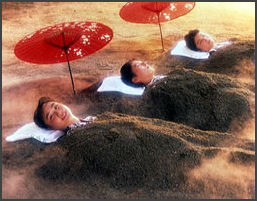
Ibusuki (50 kilometers south of Kagoshima) is one of Japan's most famous hot spring resorts. Located on the southernmost tip of the Satsuma Peninsula, this town is noted for its sub-tropical vegetation, white sand beaches and natural hot sand baths which can be taken right on the beach.
Ibusuki is filled with modern hotels and traditional inns. The Ginsho Hotel charges visitors ¥710 for the pleasure of being buried in hot black sand heated by natural steam and water from hot water springs passing through the sand. Ibusuki is the only place in the world where you can enjoy this unique experience. Altogether a 16-mile stretch of beach is heated by subterranean volcanic activity.
People have been taking the baths for more than 300 years. One person in the 19th century described them as “curing all kinds of illnesses and especially good for muscles and bones.” In the last hundred years they have been commonly used by farmers in the off season. Westerners first became aware of Ibusuki when it was featured in a Life magazine article in the 1960s. One facility today welcomes 270,000 to 300,000 visitors a year, with 80 percent of them coming from outside Kagoshima. These days more and more are coming from South Korea, China and Taiwan.
Describing his experience at a bath facility called Saraku, Shoicho Nasu wrote in the Daily Yomiuri, “I simply went to front desk and paid a ¥900 bathing charge and was issued a special yukata to wear in the sand bath. In the changing room, I stripped off all my clothes and put on a yukata, went outside the building and wandered along the beach. There I saw a simple structure offering a kind of roof over the natural sand baths. Up to about 100 people can lie under the roof.”
“I lay down as instructed by one of the staff. The staff member, who happened to be a woman, poured sand all over my body with a shovel. All except my head that is. As she chatted about the tremendous beneficial affects of the sand bath, a man laying behind me joined our conversation. Saying that he came to this place regularly and never needed any doctors or medicines.
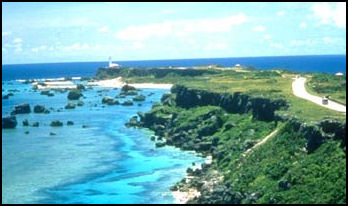
Miyako Island “Although the woman told me that most people lie down for about 10 minutes in the sand, I did so for half an hour. It felt so good with the pressure of the sand all over my body. But I did find that some time after lying down I began to sweat profusely, from my brow especially. To tell the truth. I was able to hold on for as long as I did only by keeping one thing in mind: the thought of a refreshing glass of draft beer...and the beer I had after washing off all the sand in the bathing area next to the changing room certainly did taste good.”
Websites: Sand Bath site Hakusikan ; Frommers Frommers.com ; Map: ibusuki.or.jp/info Budget Accommodation: Japan Youth Hostels Japan Youth Hostels Check Lonely Planet books Getting There: Ibusuki is accessible by bus and train from Kagoshima. Lonely Planet Lonely Planet
Shigetomi Beach is situated in an area characterized by its beautifully varied scenery, featuring the largest tidal flat in Kinkowan Bay, a beach with white sand and green pine trees stretching for several hundred meters, and a majestic view of Mt. Sakurajima. In summer, the coast is lively with many visitors who come to swim in the ocean.
See Separate Article KAGOSHIMA AND SOUTHERN KYUSHU factsanddetails.com
Beach Areas in Okinawa
There are lots of nice beaches with clear water on Okinawa and other islands south of the main Japanese islands. The northern part of the main island of Okinawa is relatively unspoiled. There are nice beaches at Sesoko-jima Island, Minna-jima Island and Okuma beach. The Miyako Islands (190 miles southwest of Okinawa) contains nice beaches and snorkeling and diving reefs.
Many of the Okinawan beaches consist of ground coral mixed with sand. Some may charge an admission fee. The military beaches are free. The northern half of Okinawa is sparsely populated and features a beautiful coastline of mountains and coral 'reefs. Windsurfing, parasailing and other marine sports are enjoyed in Okinawa. Jungle and canoe trips are run by local eco-tourism groups.
See Separate Article OKINAWA factsanddetails.com
Ryukyu Islands
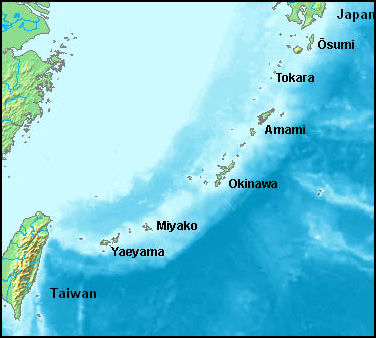
Ryukyu Islands(south of Kyushu) extend for around 1,000 kilometers from 40 kilometers south of Kyushu to 100 kilometers east of Taiwan. Some of the 200 or so islands are volcanic. Most are made from coral. The islands in northern half of the island chain, including the Osumi Islands, are part of Kagoshima Prefecture in Kyushu. The four island groups in the southern half are part of Okinawa prefecture. The climate is considerable warmer than the main islands. The area is often struck by typhoons in the summer. During the winter months the temperatures are cool but the water visibility is at its best.
Miyako Islands (190 miles southwest of Okinawa) contains nice beaches and snorkeling and diving reefs. Hirara is the largest town on the largest island. The islands largely escaped the ravages of World War II and there are remnants of the Ryuku Culture. Websites: Okinawa tourism site visitokinawa.jp ; Wikitravel Wikitravel ; JNTO japan.travel/en ; Getting There: Lonely Planet Lonely Planet
Yaeyama Islands (between the Miyako Islands and Taiwan) are famous for black pearls, star-shaped sand and the Iriomote wildcat. Home to nice beaches and snorkeling and diving reefs and large wilderness areas, they have been described as the Galapagos of Asia because of the high number of unique birds, plants and butterflies found there,
See Separate Article RYUKYU ISLANDS NORTH AND SOUTH OF OKINAWA factsanddetails.com
Image Sources: 1) Chiba Tourism 2) 3) 5) 7) Okinawa Convention and Visitors Bureau 4) 6) Tokyo Islands
Text Sources: New York Times, Washington Post, Los Angeles Times, Daily Yomiuri, Times of London, Japan National Tourist Organization (JNTO), National Geographic, The New Yorker, Time, Newsweek, Reuters, AP, Lonely Planet Guides, Compton’s Encyclopedia and various books and other publications.
Last Updated: June 2023
